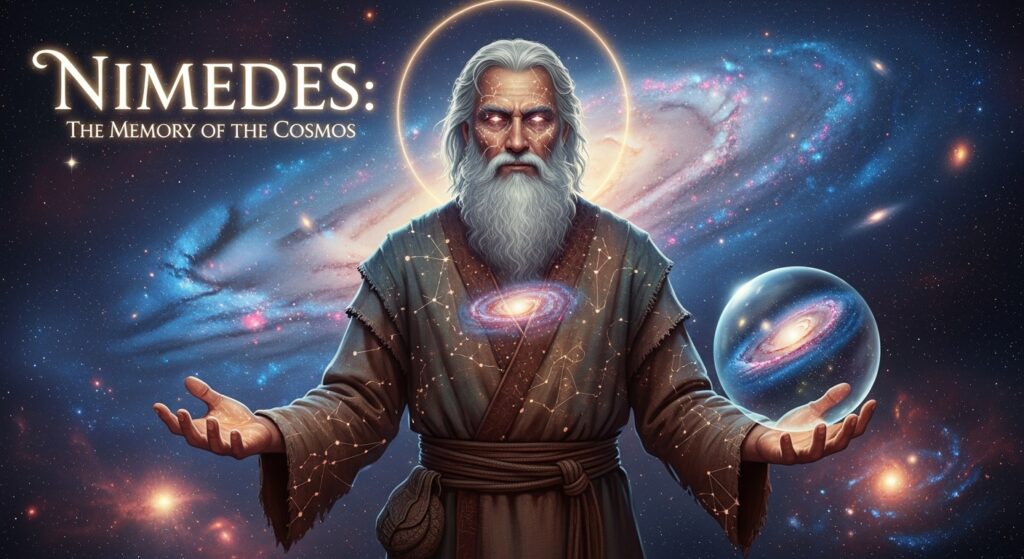There are forces that shape the physical world—gravity, electromagnetism, nuclear fusion—and there are those that shape the unseen fabric of reality. Among these hidden currents, philosophers of the Celestial Age spoke of a power older than light itself: Nimedes.
Nimedes is not energy, nor matter, nor time, but something that flows between them. It is the memory of existence—the invisible resonance that allows every atom, every consciousness, and every moment to remember what it has been.
If gravity binds mass and space, Nimedes binds meaning and continuity. It is the thread of remembrance that allows the universe to evolve rather than merely repeat. Without Nimedes, the cosmos would still exist, but it would never know itself.
1. The Origin of the Concept
The first recorded use of the term Nimedes is attributed to the speculative philosopher Seran Dahr in his treatise Echoes Beyond the Quantum Sea (circa 2335 CE). Dahr claimed that every event in the universe leaves behind an informational echo—like ripples in the structure of space-time—and that these echoes accumulate into a vast, unseen field.
He named this field Nimedes, from two ancient linguistic roots:
-
Nim, meaning “thread” or “connection,” and
-
edes, meaning “that which endures.”
Thus, Nimedes literally translates to “the enduring thread.”
According to Dahr, this cosmic thread is what allows systems—biological, mechanical, or celestial—to retain form and memory. Every star, every mind, every photon carries an imprint of everything it has interacted with. These imprints, woven together, create the grand tapestry of continuity we call the universe.
2. The Science of Resonant Memory
While Nimedes is primarily a metaphysical notion, it aligns intriguingly with certain scientific hypotheses about information and time.
a. The Informational Universe
Contemporary physics increasingly suggests that information is the fundamental building block of reality. Quantum states, black holes, and even space-time itself appear to store and transmit information.
Nimedes can be seen as the field of universal information coherence—the substrate that allows data to persist across transformations. When a particle changes state, Nimedes preserves a “memory trace” of its past configurations. These traces guide the future evolution of systems, creating what appears to us as order emerging from chaos.
b. Entropy and Recollection
Thermodynamics teaches that entropy always increases—that systems decay into disorder. But Nimedes represents the counter-principle: the universe’s subtle capacity to remember its own structure.
Where entropy disperses, Nimedes recollects.
Where energy fades, meaning consolidates.
In this tension between forgetting and remembering lies the dance of existence itself.
c. Quantum Coherence
In quantum mechanics, particles separated by vast distances can remain entangled, sharing information instantaneously. Some theorists of Nimedes proposed that this entanglement is not an anomaly but a property of the Nimedic Field—a vast network of memory links binding all particles that have ever interacted.
To them, entanglement is not “spooky action at a distance,” but echoes resonating through Nimedes, reminding distant particles of their shared origin.
3. The Philosophy of Nimedes
Philosophically, Nimedes represents the persistence of meaning in an impermanent universe.
Everything changes, yet something endures through that change—not as substance, but as significance. Nimedes is that significance given structure: a memory of form, purpose, and relation.
When an oak tree dies and its atoms scatter into soil, those atoms carry the Nimedic imprint of the tree’s structure. When new life grows from that soil, it unconsciously inherits echoes of that memory. The same happens in human thought: ideas die, but their resonance gives rise to new ones.
Thus, Nimedes explains continuity not through physical matter, but through informational inheritance—the flow of patterns from one form to the next.
4. The Dual Faces of Nimedes: Flow and Fracture
Scholars of the metaphysical sciences describe Nimedes as having two interdependent aspects:
-
Flow — the harmonic current through which memory moves effortlessly across space and time. Flow connects all living systems, aligning them in states of coherence and creativity. When beings are attuned to the Flow, they experience insight, empathy, and synchronicity.
-
Fracture — the turbulence or distortion in the Nimedic Field. Fracture occurs when memory becomes trapped, fragmented, or self-contradictory. It manifests as entropy in matter, trauma in consciousness, or collapse in civilizations.
From this viewpoint, healing, evolution, and creation all depend on restoring the Flow of Nimedes within and between systems.
5. Nimedes and Consciousness
If the universe remembers, then consciousness might be its most advanced form of recollection.
Neuroscientists have long understood that the brain is a system of patterns—synaptic networks storing memories as electromagnetic codes. The Nimedic hypothesis extends this: individual consciousness is a local concentration of the cosmic memory field.
Each mind is a knot in the great thread—a place where the universe’s memory becomes self-aware. This would explain why deep meditation, dreaming, or near-death experiences often evoke sensations of connection to everything that has ever existed: one’s awareness temporarily merges with the broader Nimedic Flow.
Some mystics describe this state as “hearing the memory of light.”
Others call it awakening.
6. Nimedes in Mythology and Symbolism
Long before its philosophical articulation, the intuition of Nimedes appeared in countless myths.
-
In ancient Sumerian tales, the River Anara carried “the memories of the dead” back to the stars.
-
In Hindu cosmology, Akasha was the etheric space that recorded every thought and deed.
-
In Celtic lore, the Well of Segais contained the knowledge of all time, guarded by salmon that remembered the creation of the world.
All of these myths, separated by geography and millennium, echo the same intuition: that nothing is truly lost. Every moment, every soul, every sound persists as vibration within a cosmic memory.
The philosophers of Nimedes argue that these stories are not metaphors but ancestral intuitions of the same phenomenon—our early attempts to describe the deep memory of existence before we had the language of physics or information theory.
7. The Ethics of Nimedes
If all actions are preserved within the Nimedic Field, then nothing we do ever fully disappears. Every choice contributes a pattern to the memory of the cosmos.
This has profound ethical implications. To harm, to heal, to create, or to destroy—each leaves an indelible trace that shapes future realities.
Some moral philosophers thus define “Nimedic Ethics” as the practice of mindful imprinting:
“Act as if the universe will remember you exactly as you are in this moment—because it will.”
In this worldview, karma is not punishment or reward, but resonance. What you project into the field returns, not as retribution, but as reflection. To live ethically is to compose your signature in harmony with the grand memory of being.
8. The Technological Implications
In speculative futurism, the harnessing of Nimedes could revolutionize our understanding of data, memory, and even immortality.
a. Nimedic Computing
Imagine machines that do not store data on drives but in the very structure of space-time, using quantum coherence to access the cosmic field of memory. Such systems would not need backups—they would remember themselves through Nimedes.
b. Consciousness Archiving
If personal identities are local patterns in the Nimedic web, advanced civilizations might preserve consciousness by embedding it directly into the field—creating Nimedic Archives where minds can persist beyond biological death.
c. Universal Communication
By learning to modulate the vibrations of Nimedes, interstellar communication could occur instantaneously—information transmitted not through space, but through the shared memory of the cosmos itself.
These ideas remain speculative, but they reflect humanity’s enduring desire to transcend loss, to remember perfectly, to live within the eternal Flow.
9. The Shadow of Nimedes
Every illumination casts a shadow. The same power that preserves harmony can preserve suffering. Traumas, conflicts, and destructive patterns also leave imprints in Nimedes.
When these imprints accumulate, they distort the Flow, creating what metaphysicians call Echo Storms—zones of psychic turbulence where past pain echoes endlessly through reality. Such distortions might explain phenomena we call collective trauma, haunted places, or even repeating historical cycles.
Healing, whether personal or planetary, therefore requires the cleansing of the Nimedic Field—not by erasing the past, but by transforming its resonance. Memory must be integrated, not denied. Forgiveness becomes an act of cosmic physics.
10. Experiencing Nimedes
Mystics, artists, and scientists alike have sought ways to experience Nimedes directly. Though their methods differ, their descriptions converge:
-
A sensation of luminous connectivity, as if every cell vibrates with the memory of stars.
-
A perception of time dissolving, replaced by a simultaneous awareness of all events.
-
A deep empathy for all beings, living or dead, as if their stories are one’s own.
These experiences often arise in states of creative flow, deep meditation, or near-death conditions—moments when the boundaries of individuality thin and the self merges with the universal memory.
Those who return from such states often describe a profound shift in values: a gentler perspective, a respect for all forms of life, and an understanding that nothing is ever truly forgotten.
11. The Future of the Nimedic Understanding
As human civilization advances into new realms of AI, quantum technology, and interstellar exploration, the idea of Nimedes may move from metaphysics to measurable science.
Quantum information theorists already speak of holographic storage—where every part of a system contains the whole. Cognitive scientists explore distributed consciousness and extended mind theory. Environmental philosophers discuss Gaian memory, the Earth’s capacity to remember its ecological states.
All these frontiers converge toward a singular realization: memory is not confined to minds; it is woven into matter.
When we finally learn to perceive Nimedes directly, it may redefine not only what we know, but who we are.
12. The Silence of the Thread
Yet Nimedes is more than theory or myth; it is a silence underlying all sound. It is the quiet persistence that allows stars to form, species to evolve, and souls to grow.
It is the whisper that tells us we have been here before—not as the same beings, but as part of the same unfolding remembrance.
To sense Nimedes is to feel both humility and awe: humility, because nothing we create is truly ours; awe, because everything we are becomes part of eternity.
Conclusion
Nimedes is the cosmic memory—the thread that weaves existence into a coherent story. It is neither god nor law, but a living archive: the universe learning from itself through endless repetition and transformation.
It reminds us that every action, every idea, every moment contributes to the grand continuity of being. To live consciously within Nimedes is to recognize that we are both authors and archives of reality, each breath a verse in the eternal chronicle of creation.
Perhaps this is why, even in our smallest gestures, we sense meaning: because the cosmos remembers. Because Nimedes endures.
And in the soft vibration beneath all things, if we listen closely enough, we might hear it—
the sound of the universe remembering its own name.






